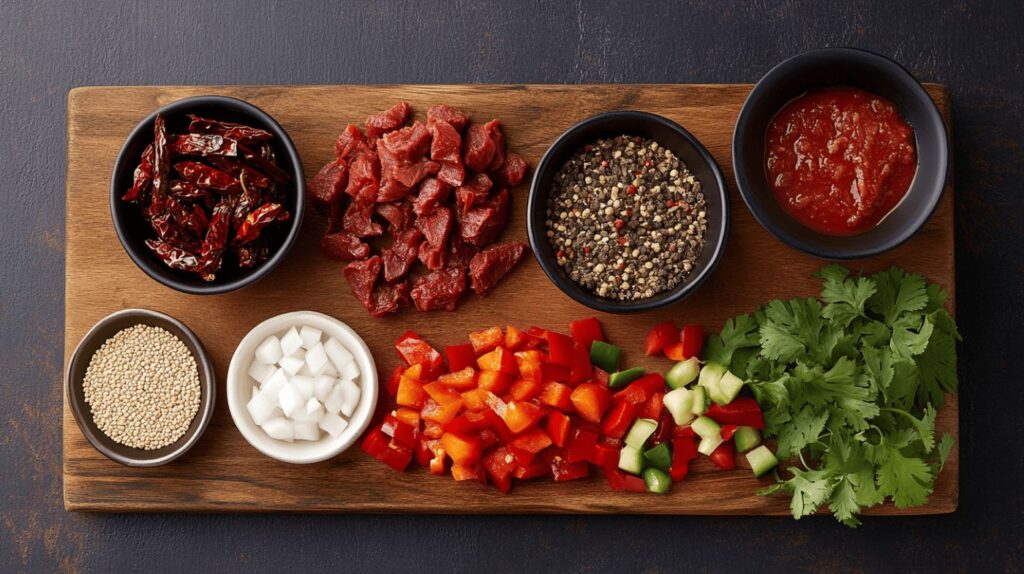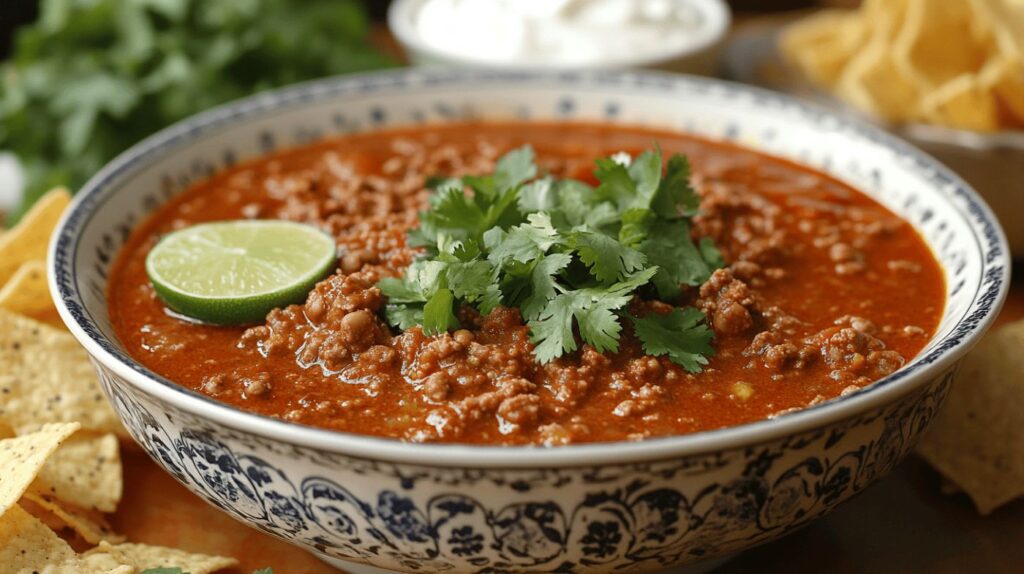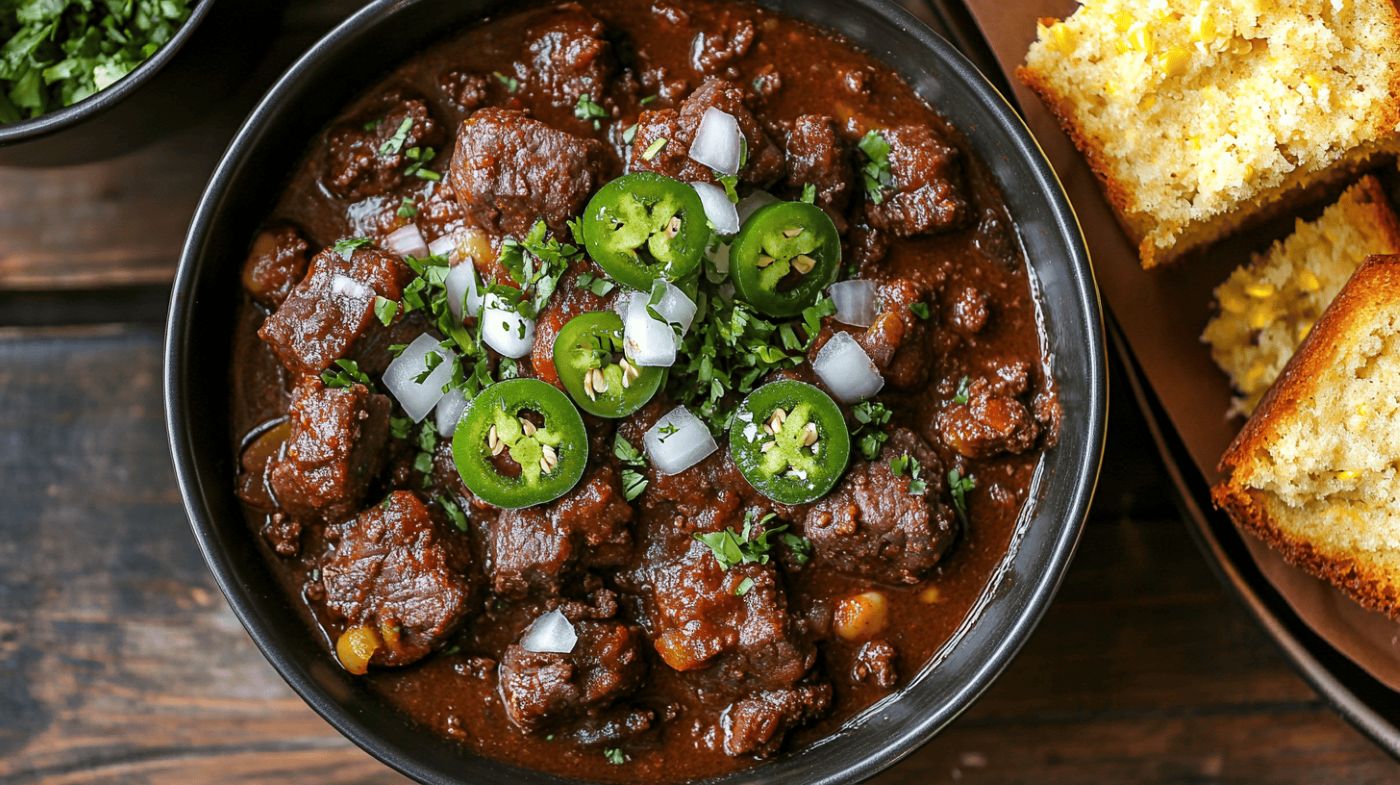Table of Contents
What Makes Texas Chili Different?
When it comes to iconic dishes, few foods are as synonymous with Texas as its signature chili. Rich, bold, and steeped in history, Texas chili is more than a recipe—it’s a cultural institution. What sets it apart from other chili varieties isn’t just the flavor but also the traditions, techniques, and pride that go into every pot.
The Origins of Texas Chili
The origins of Texas chili are as colorful as the state itself. This dish was born out of necessity, ingenuity, and the unique blending of cultures that shaped Texas.
- The role of cowboys and trail cooking
In the 1800s, Texas was a land of vast open spaces, cattle drives, and hardworking cowboys. Cowboys needed meals that were portable, filling, and easy to cook over open fires during their long journeys. Enter chili: a simple yet hearty stew made from dried beef, chili peppers, and a few basic spices.
Dried beef was a trail staple because it was lightweight and preserved well. Chili peppers, often grown locally or traded from Mexico, were used to add flavor and mask the taste of less-than-fresh meat. Combined with a handful of seasonings like cumin and garlic, these ingredients created a dish that was both practical and delicious. Over time, chili became more than just a trail food—it was a taste of home for many Texans.
- How chili became an iconic Texas dish
By the late 19th century, chili’s popularity had spread beyond the trails. In San Antonio, “chili queens” set up food stands in public plazas, serving bowls of spicy chili to locals and tourists. These women played a key role in cementing chili as a Texan culinary icon. Their recipes, often passed down through generations, highlighted the bold flavors and rich textures that define Texas chili.
As Texas grew, chili became a staple in homes, restaurants, and even political events. Today, it’s celebrated as the state dish of Texas, representing the rugged spirit and diverse heritage of the Lone Star State.If you’re inspired to try an authentic recipe yourself, The Best Texas Chili Recipe: Simple, Smoky, and Delicious offers a great starting point.
Defining Characteristics of Texas Chili
What truly sets Texas chili apart from other styles is its unapologetic simplicity. It’s all about the meat and the spices, with no distractions.
- The no-beans policy
One of the most defining features of Texas chili is its strict “no-beans” rule. Texans argue that beans are a filler, detracting from the pure, unadulterated flavors of the chili. While other regions might add beans for texture or bulk, Texas chili stays true to its roots by focusing on the essentials: meat and chili peppers.
This preference dates back to the dish’s origins. Cowboys and early chili makers didn’t have access to beans on the trail, so their recipes naturally excluded them. Over time, this practical decision evolved into a point of pride, and today, adding beans to Texas chili is considered sacrilegious by purists.For a look at how another classic Texan dish handles ingredients, explore What Is Cowboy Chili Made Of? A Complete Ingredient Breakdown.
- Focus on chili peppers and meat
At the heart of Texas chili are two key ingredients: chili peppers and meat. The peppers provide the signature heat and smoky flavor, while the meat adds richness and substance. Unlike other chili styles that use ground beef, Texas chili often features larger chunks of beef, like brisket or chuck roast, which hold up well during slow cooking.
The emphasis on these ingredients reflects the dish’s simplicity and boldness. Each bite is a celebration of robust, earthy flavors, with no unnecessary frills.

Ingredients That Make Texas Chili Unique
The ingredients used in Texas chili are carefully chosen to create its distinctive taste. From the choice of chilies to the blend of spices, every element plays a role in crafting the perfect bowl.
- The magic of dried chili varieties
Dried chilies are the soul of Texas chili. Varieties like ancho, guajillo, and pasilla are commonly used for their complex flavors, which range from sweet and smoky to earthy and mildly spicy. These chilies are typically rehydrated and blended into a thick paste, creating a rich base for the stew.
Each type of chili contributes something unique. Ancho chilies, for example, add a mild sweetness, while guajillo chilies bring a tangy, slightly fruity note. Together, they create a depth of flavor that fresh chilies can’t replicate.
- Traditional seasonings and their role
In addition to chilies, Texas chili relies on a handful of traditional seasonings. Cumin adds warmth and an earthy undertone, while garlic and oregano enhance the overall flavor profile. These spices are used sparingly, allowing the chilies and meat to shine.
Some recipes also include a splash of coffee or a bit of dark chocolate to enhance the richness of the dish. These ingredients are subtle but add complexity, making the chili even more satisfying.For inspiration on balancing spices in another classic dish, check out Perfect Cracker Barrel Meatloaf Recipe: A Complete Guide.
Texas Chili vs. Other Regional Styles
Chili is a dish with countless regional variations, each with its own unique twist. Comparing Texas chili to other styles highlights what makes it so distinctive.
- Cincinnati chili: sweet and spicy differences
Cincinnati chili is a world away from Texas chili. It’s known for its sweet, aromatic flavor, often achieved with spices like cinnamon, nutmeg, and cloves. Unlike Texas chili, it’s typically served over spaghetti and topped with shredded cheese, onions, and beans.
While Cincinnati chili is milder and more complex in its sweetness, Texas chili is bold, spicy, and straightforward. The two styles couldn’t be more different, yet each has its own loyal following.
- New Mexico chili: green chilies vs. red chilies
In New Mexico, chili takes on a different form entirely. Green chilies, often roasted and blended into sauces, are a staple of New Mexican cuisine. Red chilies are also used, but they’re prepared in a lighter, more soupy style compared to Texas chili.
New Mexico’s focus on fresh green chilies contrasts sharply with Texas chili’s reliance on dried chilies. While both styles are rich in flavor, Texas chili’s smoky, concentrated taste sets it apart.
The Culture and Ritual of Texas Chili Cook-Offs
Chili cook-offs are a cherished tradition in Texas, bringing together home cooks, professional chefs, and chili enthusiasts to celebrate their love of the dish.
- What judges look for in authentic Texas chili
At a Texas chili cook-off, authenticity is key. Judges evaluate the color, texture, and aroma of each entry, looking for a deep, reddish-brown hue and a thick, hearty consistency. The flavor should be well-balanced, with just the right amount of spice to make an impression without overwhelming the palate.
Presentation also matters. A true Texas chili should look as good as it tastes, with no excessive grease or unappealing textures.
- The impact of cook-offs on Texas food culture
Cook-offs are more than just competitions—they’re community events that bring people together. These gatherings celebrate Texas culture, food, and the art of chili-making, fostering a sense of pride and camaraderie among participants and attendees.
How to Make Authentic Texas Chili at Home

Making Texas chili at home is a rewarding experience that allows you to connect with its rich history and bold flavors.
- Key steps for an authentic taste
Start by selecting high-quality meat, such as beef chuck or brisket. Brown the meat in a hot pan to develop a deep, caramelized flavor. Rehydrate dried chilies by soaking them in hot water, then blend them into a smooth paste. Combine the meat, chili paste, and seasonings in a pot, and let the chili simmer slowly for several hours. - Tips and tricks for perfection
Patience is key when making Texas chili. Allowing the stew to simmer over low heat helps the flavors meld and intensify. Be sure to taste and adjust the seasoning as you go, adding more salt or spice if needed. And don’t forget to serve your chili with classic accompaniments like cornbread or tortillas.
FAQs About Texas Chili
Texas chili is a topic that sparks curiosity and debate. Here are answers to some of the most frequently asked questions about this iconic dish.
Why does Texas chili avoid beans?
Texas chili avoids beans to maintain its focus on the bold flavors of meat and chilies. This tradition stems from the dish’s origins as a trail food, where cowboys relied on dried meat and chili peppers rather than perishable ingredients like beans. Over time, this practice became a defining feature of Texas chili, reflecting its simplicity and authenticity. Texans also argue that beans dilute the dish’s robust, smoky taste, distracting from its true essence.
What are the best meats for Texas chili?
The best meats for Texas chili are cuts that can withstand long cooking times while becoming tender and flavorful. Beef chuck and brisket are top choices due to their rich flavor and marbled fat. Ground beef is sometimes used for convenience, but traditional recipes often call for larger chunks of meat to give the chili a hearty texture. Venison is another excellent option, especially for those who want a gamier flavor.
Can Texas chili be made vegetarian?
While traditional Texas chili is centered around meat, it is possible to create a vegetarian version. Substituting meat with textured vegetable protein (TVP), jackfruit, or hearty vegetables like mushrooms and zucchini can mimic the texture of meat. However, purists may argue that vegetarian chili doesn’t truly capture the spirit of Texas chili, as meat and chilies are integral to its identity.
What is the best way to serve Texas chili?
Texas chili is best served piping hot in a bowl, allowing its rich aromas and bold flavors to shine. Many Texans prefer to keep it simple, garnishing the chili with a sprinkle of shredded cheese, a dollop of sour cream, or a few chopped onions. Others enjoy pairing it with freshly baked cornbread or a stack of warm flour tortillas to soak up the savory broth.
What side dishes pair well with Texas chili?
Several side dishes complement the bold flavors of Texas chili. Cornbread is a classic choice, providing a slightly sweet contrast to the chili’s smoky heat. Tortilla chips or crackers can add a satisfying crunch. For a fresh element, a simple green salad or coleslaw works well. Some also enjoy serving chili with a side of Mexican rice or refried beans to round out the meal.
What’s the difference between Texas chili and regular chili?
The main difference lies in the ingredients and preparation. Texas chili focuses on meat and chili peppers, strictly avoiding beans and tomatoes, which are common in other chili recipes. Regular chili often includes beans, ground beef, and a tomato-based sauce, resulting in a lighter, more stew-like consistency. Texas chili, on the other hand, is thicker, richer, and spicier, with an emphasis on bold, smoky flavors.
What is real Texas chili made of?
Real Texas chili, often called “chili con carne,” is made with chunks of beef or venison, dried chili peppers (such as ancho, guajillo, and pasilla), and traditional seasonings like cumin, garlic, and oregano. The dish is slow-cooked to develop its deep, complex flavors, with no beans or tomatoes included. Some recipes add a touch of masa harina or cornstarch to thicken the chili further.
What is a distinguishing feature of Texas chili?
The most distinguishing feature of Texas chili is its “no-beans” policy. This sets it apart from other regional chili styles and highlights its emphasis on simplicity. Additionally, the use of dried chili peppers and larger cuts of meat instead of ground beef gives Texas chili a robust texture and flavor profile that distinguishes it from its counterparts.
Why doesn’t Texas chili have beans?
The absence of beans in Texas chili dates back to its roots as a practical meal for cowboys and early settlers. Without refrigeration, they relied on dried and preserved ingredients, such as meat and chili peppers. Beans were not readily available or practical on the trails, and this tradition has endured as a point of pride for Texans. By avoiding beans, the dish maintains its bold, meat-centric identity.
Conclusion: Why Texas Chili Stands Out
Texas chili is a dish that embodies the spirit of the Lone Star State. Its bold flavors, simple ingredients, and rich history make it a standout among regional chili styles. Whether you’re savoring a bowl at a cook-off or making it at home, Texas chili is more than just a meal—it’s a taste of Texas pride and tradition.

